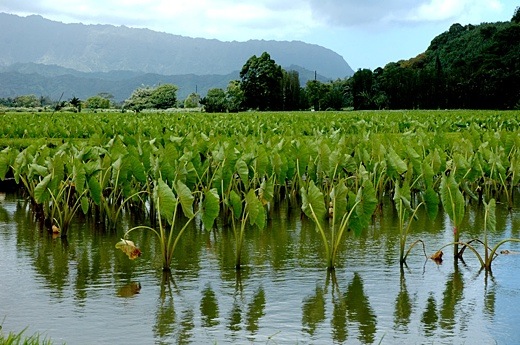SUBHEAD: Research determines acreage Hawaiians used for growing.
By Helen Altonn 21 December 2009 in the Star Bulletin -
(http://www.starbulletin.com/news/20091221_early_ag_lands_identified.html)

Image above: Wetland taro growing in Hanalei Valley on Kauai, Hawaii. From http://www.trekearth.com/gallery/photo448684.htm
Combining technology and traditional archaeology, scientists have identified thousands of acres of land farmed by early Hawaiians.
By Helen Altonn 21 December 2009 in the Star Bulletin -
(http://www.starbulletin.com/news/20091221_early_ag_lands_identified.html)

Image above: Wetland taro growing in Hanalei Valley on Kauai, Hawaii. From http://www.trekearth.com/gallery/photo448684.htm
Combining technology and traditional archaeology, scientists have identified thousands of acres of land farmed by early Hawaiians.
The findings also have implications for crop self-sufficiency in Hawaii -- that is, the possibility of ending the need for agricultural imports.
"At the peak of Hawaiian population, there were perhaps a million people," said Samuel M. Gon III, ecologist, cultural adviser and senior scientist with The Nature Conservancy. "It takes thousands and thousands of acres to feed all those people. Where was all that farmland?"
He said scientists began collaborating to find the answer to that question and the findings have broad implications for anthropology and conservation biology.
Early Hawaiian language newspapers referred to agricultural systems that aren't known today, either because they were abandoned, destroyed by sugar and pineapple cultivation or "they're in places where no one has looked," the researchers said.
They compared results of the computer models with what was known from more than 100 years of archaeological research to learn what has been lost.
The computerized model indicated a massive part of Kau on Hawaii island was suited for Hawaiian dryland agriculture -- thousands of acres above the South Point wind generator farm and below Mamalahoa Highway, according to the Conservancy news release.
Researchers expanded a project that began in the Kohala region to the entire Island chain, using so-called Geographic Information Systems modeling to see where early Hawaiians did dryland and wetland agriculture.
The technology could be used to determine the best habitats to grow rare plants, Gon said. The findings also suggest "we can wean our reliance on food from the outside world," he said.
A vast dryland farming system that grew sweet potatoes had already been discovered in the Kohala project with two former Honolulu residents as principal investigators: Peter Vitousek, a Stanford University ecologist, and Patrick Kirch of the University of California at Berkeley. Also participating was Thegn N. Ladefoged of New Zealand's University of Auckland.
The three joined with Gon, soil scientist Oliver A. Chadwick of the University of California at Santa Barbara, and environmental scientist Anthony S. Hartshorn of Arizona State's School of Earth and Space Exploration to apply GIS modeling across the state.
Their work is described in the Conservancy news release and in a paper in the Journal of Archaeological Science entitled "Opportunities and constraints for intensive agriculture in the Hawaiian archipelago prior to European contact."
"We went to Google Earth to take a look," said Vitousek, who is familiar with the network of earthen and stone walls in Hawaiian dryland agriculture. He recognized the images on the screen. "There it was! You could see the walls. They're unbelievable," he said.
What was surprising in the GIS modeling, Gon said in an interview, was the coupling of taro or kalo with landscape flat enough and wet enough for its biology.
"The match between where kalo can grow and was grown was remarkable," he said. "Wow! Everywhere it could be grown pretty much it was being grown."
Kirch, an anthropologist who has done extensive research throughout Hawaii, said he was "blown away" by the huge extent of wet taro lands, especially on Kauai. "I really didn't have a clue it was so extensive. ... It was an incredible breadbasket of wet taro lands," he said in an interview.
The researchers said they were shocked at the extent of dry and wetland agriculture and the distribution, with dryland farming mostly on the younger islands of Maui and the Big Island and wetland agriculture on the older islands of Oahu and Kauai.
"People think the islands are the same -- that Hawaiians grew taro and sweet potatoes -- but they really are different up and down the archipelago," Kirch said.
"This has all kinds of implications, not just for the economic system in ancient Hawaii but the political system as well," he said, pointing out that dryland systems, subject to drought and harsh conditions, wouldn't be as productive as wet taro lands.
"I can see why (Maui chief) Kahekili and (Hawaii chief) Kamehameha wanted to conquer Oahu and Kauai to get rich taro lands. It's real interesting when you look at what was going on politically at the time of contact."
See also:
File Format: PDF - "The Transformation of the landscape in Waimea, Hawaii: Pre-Human..."
https://scholarspace.manoa.hawaii.edu/bitstream/10125/7089/2/uhm_ma_3048_r.pdf
1 comment :
this is far and away the most interesting article i have read on the site for months. great work finding it.
Post a Comment